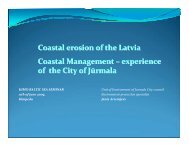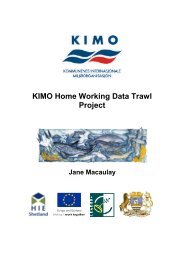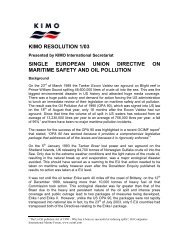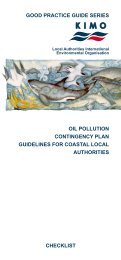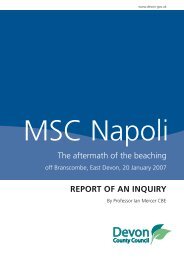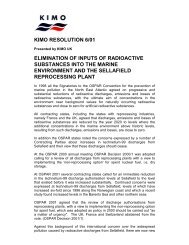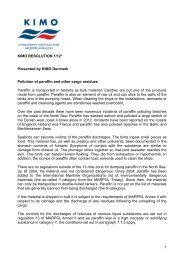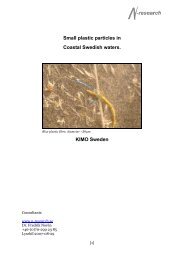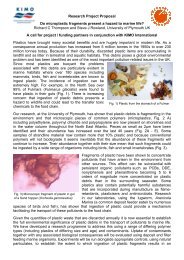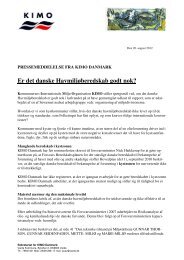Pesticide Use in Amenity Areas Good Practice Guide- Checklist - KIMO
Pesticide Use in Amenity Areas Good Practice Guide- Checklist - KIMO
Pesticide Use in Amenity Areas Good Practice Guide- Checklist - KIMO
You also want an ePaper? Increase the reach of your titles
YUMPU automatically turns print PDFs into web optimized ePapers that Google loves.
Contents<br />
Introduction 1<br />
<strong>Guide</strong>l<strong>in</strong>es <strong>Checklist</strong><br />
Section 1 Audit<strong>in</strong>g 5<br />
Section 2 Policy 7<br />
Section 3 Risk Assessment 8<br />
Section 4 Legislation 10<br />
Section 5 Health and Safety 11<br />
Section 6 Storage of <strong>Pesticide</strong>s 13<br />
Section 7 Disposal of <strong>Pesticide</strong>s 14<br />
Section 8 Record Keep<strong>in</strong>g 16<br />
Section 9 Prepar<strong>in</strong>g Contracts 17<br />
Section 10 Alternatives to <strong>Pesticide</strong>s 18<br />
Section 11 Conclusions 19
Introduction<br />
Background<br />
Synthetic chemical pesticides have been<br />
used for nearly half a century <strong>in</strong> the control<br />
of agricultural, public health, amenity and<br />
<strong>in</strong>dustrial areas. <strong>Pesticide</strong>s are the only<br />
group of chemicals that are designed to be<br />
toxic to liv<strong>in</strong>g organisms and are <strong>in</strong>tentionally<br />
dispersed <strong>in</strong> the environment. As a<br />
result of their extensive use over time<br />
pesticides have become one of the ma<strong>in</strong><br />
sources of hazardous substances <strong>in</strong> the<br />
mar<strong>in</strong>e environment. This is a result of<br />
<strong>in</strong>puts from diffuse sources, <strong>in</strong> particular run<br />
off from agricultural land and built up areas.<br />
In the mar<strong>in</strong>e environment these chemicals<br />
can have adverse effects on mar<strong>in</strong>e life and<br />
can affect the food cha<strong>in</strong> result<strong>in</strong>g <strong>in</strong><br />
potential hazards to public health.<br />
Def<strong>in</strong>ition<br />
A pesticide is any substance, preparation or<br />
organism prepared or used for destroy<strong>in</strong>g<br />
any pest i.e. weeds, <strong>in</strong>sects, diseases,<br />
rodents, moss and algae.<br />
1
The purpose of this <strong>Guide</strong><br />
This guide has been specifically produced<br />
to expla<strong>in</strong> the issues surround<strong>in</strong>g pesticide<br />
use <strong>in</strong> amenity areas. Although there is<br />
legislation govern<strong>in</strong>g the use of pesticides<br />
<strong>in</strong> agriculture there are few guidel<strong>in</strong>es<br />
regard<strong>in</strong>g the use of pesticides by local<br />
authorities or other amenity users. The<br />
guide also covers alternatives to us<strong>in</strong>g<br />
pesticides where possible and shows local<br />
authorities the best possible methods of<br />
reduc<strong>in</strong>g pesticide usage whilst ma<strong>in</strong>ta<strong>in</strong><strong>in</strong>g<br />
a reasonable level of weed control.<br />
The application of the<br />
<strong>Checklist</strong> and Manual<br />
This <strong>Checklist</strong> is <strong>in</strong>tended to give guidance<br />
<strong>in</strong> the use of pesticides by local authorities<br />
and should be used <strong>in</strong> conjunction the<br />
Manual. However s<strong>in</strong>ce many different<br />
countries have different policies, procedures<br />
and areas ma<strong>in</strong>ta<strong>in</strong>ed, all sections of<br />
this <strong>Checklist</strong> and Manual may not always<br />
be <strong>in</strong>dicative to all local authority circumstances.<br />
The <strong>in</strong>formation conta<strong>in</strong>ed <strong>in</strong> this document<br />
was, to the best of our knowledge,<br />
correct at the time of publication. This<br />
<strong>Guide</strong> is meant only as an “aide memoir"<br />
and <strong>KIMO</strong> assumes no responsibility for<br />
any omission or for any actions that<br />
might arise as a result of us<strong>in</strong>g this<br />
<strong>Guide</strong>.<br />
2
What are the aims of the good<br />
practice guide<br />
• To provide guidance to local authorities<br />
for alternatives to the use of chemicals<br />
for weed control <strong>in</strong> amenity areas<br />
• To identify the most appropriate and<br />
successful method of application if non<br />
chemical method is unsuitable<br />
• To provide guidance to those<br />
develop<strong>in</strong>g environmental policy for<br />
local authorities<br />
• Enable authorities to phase out<br />
pesticide use altogether<br />
What are the objectives of the good<br />
practice guide<br />
• To identify the need to reduce pesticide<br />
use <strong>in</strong> amenity areas<br />
• To provide a framework which local<br />
authorities can use to reduce their<br />
overall environmental impact<br />
• To def<strong>in</strong>e roles and responsibilities<br />
with<strong>in</strong> authorities<br />
• To identify the legal responsibilities <strong>in</strong><br />
the use and disposal of pesticides<br />
• To def<strong>in</strong>e tra<strong>in</strong><strong>in</strong>g requirements by law<br />
• To establish mobilisation procedures for<br />
best practice<br />
• To address the ma<strong>in</strong> health and safety<br />
aspects<br />
• To be an accessible work of reference<br />
to this complicated subject<br />
3
• To identify the areas which require<br />
treatment<br />
• To identify notification procedures<br />
• To <strong>in</strong>teract successfully with other<br />
relevant plans<br />
• To show how monitor<strong>in</strong>g systems can<br />
be developed and implemented<br />
• To identify procurement procedures<br />
4
Section 1<br />
Audit<strong>in</strong>g<br />
Has the local authority completed an<br />
audit on their current practices<br />
• <strong>Areas</strong> under control<br />
• How often the areas are used<br />
• Location <strong>in</strong> relation to watercourse and<br />
the public<br />
• Location <strong>in</strong> relation to health hazards<br />
• Type of surface, hard/soft<br />
• Type of grass, material cover<strong>in</strong>g the<br />
areas<br />
• Extent, nature and type of use by the<br />
public and specific users<br />
<br />
<br />
<br />
<br />
<br />
<br />
<br />
Have the areas that are chemically<br />
treated been identified<br />
• Type of weed/pest caus<strong>in</strong>g the problem <br />
• Type of chemical used<br />
<br />
• How often are the areas treated <br />
• Type of chemical, liquid/granule <br />
• Application method used<br />
<br />
• Volume of chemicals<br />
<br />
Have the areas that are not chemically<br />
treated been identified<br />
• Reasons for no treatment<br />
• Methods used if any to control weeds<br />
<br />
<br />
5
Why are chemicals be<strong>in</strong>g used<br />
• Methods used <strong>in</strong> the past and present<br />
• Public op<strong>in</strong>ions on pesticide use<br />
• Lack of alternative methods<br />
<br />
<br />
<br />
Has an assessment of storage and<br />
disposal methods been completed<br />
• Treatment and disposal of spent<br />
pesticide and conta<strong>in</strong>ers<br />
<br />
• Disposal methods for conta<strong>in</strong>ers and the<br />
wash<strong>in</strong>gs from this process<br />
<br />
• Storage facilities meet appropriate<br />
regulations<br />
<br />
• Assessment on transport<strong>in</strong>g pesticides <br />
Has staff tra<strong>in</strong><strong>in</strong>g been undertaken<br />
• Handl<strong>in</strong>g<br />
• Storage<br />
• Disposal<br />
• Transport<br />
Does the local authority have a<br />
purchas<strong>in</strong>g policy and does it <strong>in</strong>clude<br />
environmentally friendly products<br />
<br />
<br />
<br />
<br />
<br />
6
Section 2<br />
Policy<br />
Has a pesticide policy been developed <br />
Has an assessment report been<br />
carried out<br />
Have all the ultimate aims of the<br />
pesticide policy been considered<br />
<br />
<br />
• Cessation of pesticide use immediately <br />
• <strong>Pesticide</strong> reduction strategy<br />
<br />
• <strong>Pesticide</strong>s used <strong>in</strong> extraord<strong>in</strong>ary<br />
circumstances<br />
<br />
• <strong>Pesticide</strong> free authority<br />
<br />
Have all the negative and positive<br />
aspects of the policy been considered <br />
Has the draft policy been circulated to<br />
relevant departments<br />
Has the draft policy been sent out for<br />
public consultation<br />
Has the agreed policy been issued to<br />
relevant departments<br />
Has a nom<strong>in</strong>ated officer been<br />
appo<strong>in</strong>ted<br />
<br />
<br />
<br />
<br />
Have any new techniques and nonchemical<br />
alternatives been <strong>in</strong>vestigated<br />
and <strong>in</strong>corporated <strong>in</strong>to the policy<br />
<br />
7
Has the policy been reviewed and<br />
updated<br />
How often is it reviewed and updated<br />
<br />
<br />
Section 3<br />
Risk Assessment<br />
Has a risk assessment been developed<br />
Physical assessment<br />
• Identified sensitive resources<br />
• Consulted the public<br />
• Sensitivity map been produced<br />
<br />
<br />
<br />
Factors to be <strong>in</strong>cluded <strong>in</strong> risk<br />
assessment<br />
• Types of chemicals used<br />
• Quantities and frequency of handl<strong>in</strong>g<br />
• Geographic location<br />
• Sensitivity of areas<br />
• Time of year<br />
• Weather<br />
• Potential sources of pollution<br />
<br />
<br />
<br />
<br />
<br />
<br />
<br />
8
Are all sensitive areas identified<br />
Environmental<br />
• Estuaries<br />
• Fish/spawn<strong>in</strong>g grounds<br />
• Bird breed<strong>in</strong>g/flock<strong>in</strong>g grounds<br />
• Mar<strong>in</strong>e mammals<br />
• Environmentally sensitive areas<br />
• Local and mar<strong>in</strong>e nature reserves<br />
• Plankton<br />
• Designated nature conservation sites<br />
<br />
<br />
<br />
<br />
<br />
<br />
<br />
<br />
Commercial<br />
• Land and agriculture<br />
• Water <strong>in</strong>takes/extraction<br />
• Fish farms and other mariculture<br />
<br />
<br />
<br />
Recreational<br />
• Tourist/amenity beaches<br />
• Sports grounds and parks<br />
• Walk ways<br />
• Hous<strong>in</strong>g estates<br />
• Mar<strong>in</strong>as<br />
• Canals<br />
<br />
<br />
<br />
<br />
<br />
<br />
Other<br />
• Medical<br />
• Roads and highways<br />
<br />
<br />
9
Section 4<br />
<strong>Pesticide</strong> Legislation<br />
Are staff work<strong>in</strong>g with pesticides aware<br />
of EC and national legislation<br />
<br />
Have all relevant staff received tra<strong>in</strong><strong>in</strong>g<br />
and guidance <strong>in</strong> the follow<strong>in</strong>g aspects<br />
• Hazards and risks posed<br />
• Safe work<strong>in</strong>g practices<br />
• Emergency action plan<br />
• Health surveillance<br />
• Record keep<strong>in</strong>g<br />
• <strong>Use</strong> of application equipment<br />
• Disposal regulations<br />
<br />
<br />
<br />
<br />
<br />
<br />
<br />
10
Section 5<br />
Health and Safety<br />
Have all the relevant health and safety<br />
regulations been noted<br />
Have all staff associated with pesticides<br />
been tra<strong>in</strong>ed and briefed on national<br />
regulations<br />
Are staff familiar with pesticide<br />
labell<strong>in</strong>g<br />
Is there a safe work<strong>in</strong>g environment<br />
• Written health and safety programme<br />
• Health and safety risk assessment<br />
• Health and safety tra<strong>in</strong><strong>in</strong>g<br />
• Mobile first aid station/kit<br />
• Wash<strong>in</strong>g areas for equipment<br />
• Wash<strong>in</strong>g areas for protective cloth<strong>in</strong>g<br />
and staff<br />
• Artificial runn<strong>in</strong>g water supply for on<br />
site use<br />
• Separate wash<strong>in</strong>g bowls if water<br />
supply on site is impractical<br />
• Conta<strong>in</strong>ment areas for used<br />
protective cloth<strong>in</strong>g<br />
• Proper supervision and the use of<br />
tra<strong>in</strong>ed personnel<br />
• Comprehensive report<strong>in</strong>g procedure of<br />
all pesticide works<br />
• Separate area for toilet facilities and<br />
meals when on site<br />
<br />
<br />
<br />
<br />
<br />
<br />
<br />
<br />
<br />
<br />
<br />
<br />
<br />
<br />
<br />
<br />
11
Are staff familiar with application<br />
procedures<br />
Have decontam<strong>in</strong>ation procedures been<br />
identified<br />
<br />
<br />
• Identification of clean<strong>in</strong>g site for<br />
equipment and cloth<strong>in</strong>g<br />
<br />
• Identification of clean<strong>in</strong>g equipment to<br />
be kept on site<br />
<br />
• Methods to be used to clean cloth<strong>in</strong>g<br />
and equipment<br />
<br />
• Procedures for handl<strong>in</strong>g, stor<strong>in</strong>g and<br />
transport<strong>in</strong>g spent pesticide<br />
<br />
• Spent pesticide disposal plan <br />
Have the public been notified of any<br />
pesticide application procedures<br />
<br />
12
Section 6<br />
Storage of <strong>Pesticide</strong>s<br />
Are all staff <strong>in</strong>volved <strong>in</strong> the storage of<br />
pesticides aware of EC and national<br />
regulations surround<strong>in</strong>g pesticide<br />
storage<br />
Do the storage facilities meet<br />
regulations<br />
<br />
<br />
Do the storage facilities meet the criteria<br />
below<br />
<br />
• Suitably sited <br />
• Soundly constructed of fire-resistant<br />
materials<br />
<br />
• Adequate storage capacity <br />
• Provided with suitable entrances <br />
• Well lit and adequately ventilated <br />
• Capable of conta<strong>in</strong><strong>in</strong>g spillages and<br />
leakage<br />
<br />
• Dry and frost free <br />
• Marked with appropriate warn<strong>in</strong>g signs <br />
• Secure aga<strong>in</strong>st theft and vandalism <br />
• Equipped, organised and staffed to<br />
accommodate <strong>in</strong>tended contents <br />
13
Section 7<br />
Disposal of <strong>Pesticide</strong>s<br />
Have procedures for the disposal of<br />
spent pesticides been implemented<br />
<br />
• Have all regulations and legislation been<br />
considered <br />
• Has the necessary paperwork been<br />
completed <br />
• Does a licensed site and carrier<br />
exist<br />
<br />
• Has the purchas<strong>in</strong>g policy been<br />
adhered to<br />
<br />
• Have the supplier and carrier been<br />
contacted<br />
<br />
• Have potential consequences of a<br />
breach of the legal requirements been<br />
considered<br />
<br />
• Have methods of reduc<strong>in</strong>g pesticide<br />
usage been <strong>in</strong>vestigated/implemented <br />
Have the best and safest options for<br />
dispos<strong>in</strong>g of spent pesticides been<br />
considered<br />
• Supplier collects waste<br />
• Store waste<br />
• Direct disposal<br />
<br />
<br />
<br />
<br />
14
Have storage sites for spent pesticides<br />
been identified<br />
• Temporary<br />
• Intermediate<br />
• F<strong>in</strong>al<br />
Have methods to reduce the risk of<br />
spillages been <strong>in</strong>vestigated<br />
and implemented<br />
<br />
<br />
<br />
<br />
<br />
15
Section 8<br />
Record Keep<strong>in</strong>g<br />
Are records of all pesticide applications,<br />
storage and disposal kept<br />
<br />
Are the records updated regularly<br />
Are the records easily completed<br />
and <strong>in</strong>terpreted<br />
Are application records kept updated<br />
Are the records ma<strong>in</strong>ta<strong>in</strong>ed and<br />
available for the given period set<br />
by legislation<br />
Is <strong>in</strong>formation provided to the public<br />
about treated areas<br />
Are calibration records kept for<br />
monitor<strong>in</strong>g purposes<br />
<br />
<br />
<br />
<br />
<br />
<br />
16
Section 9<br />
Prepar<strong>in</strong>g Contracts<br />
Has a contract policy been developed <br />
Does the contract<strong>in</strong>g party have<br />
an understand<strong>in</strong>g of national<br />
legislation<br />
Is there a tra<strong>in</strong>ed and qualified advisor<br />
prepar<strong>in</strong>g and monitor<strong>in</strong>g contracts<br />
Have control level standards been set<br />
for contractors<br />
Do the contractors have area<br />
<strong>in</strong>formation<br />
• Clear def<strong>in</strong>ition of areas to be treated<br />
• Relevant measurements<br />
• Maps and plans<br />
Has a profile on the contractors been<br />
produced<br />
Has a contract<strong>in</strong>g monitor<strong>in</strong>g<br />
programme been developed<br />
Has an annual review on all aspects of<br />
the contract been completed<br />
<br />
<br />
<br />
<br />
<br />
<br />
<br />
<br />
<br />
<br />
17
Section 10<br />
Alternatives to <strong>Pesticide</strong>s<br />
Have alternative methods to pesticide<br />
control been considered<br />
<br />
Have each of the alternative methods<br />
been <strong>in</strong>vestigated<br />
• F<strong>in</strong>ancial implications<br />
• Viability<br />
• Availability<br />
• Public op<strong>in</strong>ion<br />
• Potential hazards<br />
• Environmental impacts<br />
Have any trials been undertaken on any<br />
alternative method<br />
<br />
<br />
<br />
<br />
<br />
<br />
<br />
Do any of the alternative methods fit the<br />
<strong>Pesticide</strong> Policy criteria<br />
<br />
18
Section 11<br />
Conclusions<br />
Are the aims of the good practice<br />
guide met<br />
• Development of an environmentally<br />
sensitive pesticides policy<br />
• Alternatives to chemicals for weed<br />
control <strong>in</strong> amenity area’s considered<br />
• Most appropriate application method<br />
identified if non chemical alternative<br />
is unsuitable<br />
• Reduction <strong>in</strong> the authorities use of<br />
pesticides<br />
<br />
<br />
<br />
<br />
Are the objectives of the good practice<br />
guide met<br />
• The need to reduce pesticide use <strong>in</strong><br />
amenity areas has been identified <br />
• The need to provide a framework<br />
which local authorities can use to<br />
reduce their overall environmental<br />
impact<br />
<br />
• The roles and responsibilities<br />
throughout the authority have been<br />
def<strong>in</strong>ed<br />
<br />
• The legal responsibilities <strong>in</strong> the use and<br />
disposal of pesticides have been<br />
identified<br />
<br />
• The areas that require treatment have<br />
been identified<br />
<br />
• Tra<strong>in</strong><strong>in</strong>g requirements have been<br />
identified<br />
<br />
19
• Mobilisation procedures for best<br />
practice have been def<strong>in</strong>ed<br />
• The ma<strong>in</strong> health and safety aspects<br />
have been addressed<br />
• To be an accessible work of reference<br />
to this complicated subject<br />
• Notification procedures have been<br />
identified<br />
• Monitor<strong>in</strong>g systems have been<br />
developed and implemented<br />
• Procurement procedures have been<br />
identified<br />
<br />
<br />
<br />
<br />
<br />
<br />
20
• Mobilisation procedures for best<br />
practice have been def<strong>in</strong>ed<br />
• The ma<strong>in</strong> health and safety aspects<br />
have been addressed<br />
• To be an accessible work of reference<br />
to this complicated subject<br />
• Notification procedures have been<br />
identified<br />
• Monitor<strong>in</strong>g systems have been<br />
developed and implemented<br />
• Procurement procedures have been<br />
identified<br />
<br />
<br />
<br />
<br />
<br />
<br />
20



